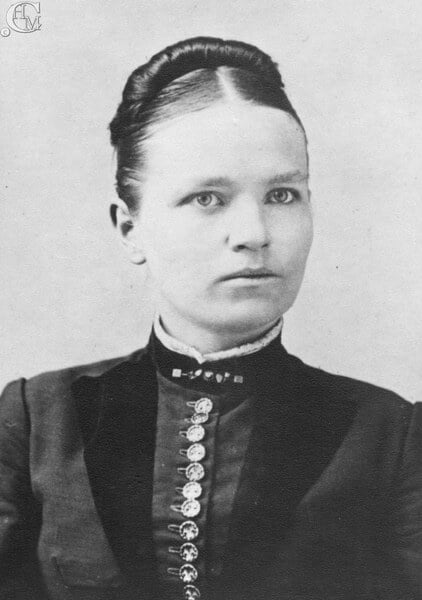Located on the west side of North 6th Street near the corner of Mike McKeehan Way, Crunk’s Hill was leveled to create sport fields. There is a plaque at the restrooms.
George W. Crunk came west from Tennessee. He served in the Union Army during the Civil War as a Private with the 20th Regiment, Kentucky Infantry, Company C. We don’t know when he came west, but by June 1878, he was farming this land with his wife, Annah, and their three children. The Crunk family did not stay long in the area, they moved to Oregon in 1883, but hill is remembered as part of Cheney lore because of an incident in the fall of 1878.
In 1915, Mary Cook Spangle spoke to Normal School students, recalling the events that gave the hill its name, as well as her teaching experience in the winter of 1878:
Soon after our arrival [September 1878] bands of renegade Indians commenced killing sheepherders and isolated settlers in the Walla Walla country. Therefore, a great many people came from that district to the Four Lakes country, as an escape. The families of the community congregated at the Covert ranch and stayed for several days until the danger cloud cleared away. From this event came the decision that we must have a fort. Under the direction of old soldiers, my father [George W. Cook] being one of them, breastworks were thrown up and a log structure erected, known by the early settlers as Fort Cronk [Crunk]. This was to serve a two-fold purpose, but, fortunately, there were no more Indian scares, so the building was used for school and church purposes.
Under the direction of old soldiers, my father [George W. Cook] being one of them, breastworks were thrown up and a log structure erected, known by the early settlers as Fort Cronk [Crunk]. This was to serve a two-fold purpose, but, fortunately, there were no more Indian scares, so the building was used for school and church purposes.

“It was on December 2, 1878, that I began teaching in this building. It has been suggested that this was the first school ever founded in Spokane county, but I think that is a mistake. However, it was perhaps the second school ever taught in this county. My pupils numbered about 15. The building was a log structure, lighted by two small windows, one on either side. In one end was a fireplace, made of rough stones, opposite it, the door. The boards of the floor were not nailed, consequently it was not a very quiet room. Perhaps you can imagine the clatter, clatter, as one walked across it. The roof was covered with shakes—which are logs split into very narrow strips.”
The boards of the floor were not nailed, consequently it was not a very quiet room. Perhaps you can imagine the clatter, clatter, as one walked across it.
“Our furnishings were very rude. The benches we saw in the schoolroom scene of The Spy of the Revolution brought me back to the days of this old schoolhouse. We had no blackboards. There was in the room one large shelf, which was used for writing purposes; it also served as a bookcase, as every night the books were gathered up from the benches and placed on this shelf. I want to tell you something interesting about the books. You will be surprised when I tell you that no two pupils had the same kind of books. How did this happen? Well, you see, these children had all recently come from different section of the East and they had brought their books with them; so, of course, it would be absolute foolishness to buy new ones when the ones they had were perfectly good. Each child studied his own lesson out of his own special kind of book.”
You will be surprised when I tell you that no two pupils had the same kind of books.

I am sure some of you are beginning to wonder about the salary. I received $65 for teaching three months, and I want to say that I never felt so rich before or since as the night I received my check. Spokane was our post office, then a town of about 150 inhabitants. One dark night, after I had been waiting some time for my school money, a knock came to the door; when we answered it we found two of the neighbor men, who had just returned from Spokane with the mail. They gave me my letter. Sixty dollars I turned over to my father to help buy a yoke of unbroken oxen, for which he paid $80. I was very proud to be able to do this, as father needed the oxen badly, all of our provisions being hauled from Walla Walla.
I taught two three—month terms there and that was all the school ever taught in that building, for one night a hard wind blew it over.
The building was a small 18 x 16-foot log structure with a split shake roof which leaked. Light came through two half-sash windows, and the stone fireplace was the only source of heat.

Joan Mamanakis







One Response
Excellent, I can picture it and know just where this was.